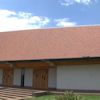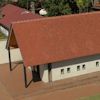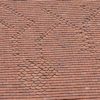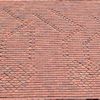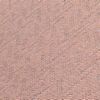ENCOMPASSART STUDIO
-ARCHITECTURAL ARTISTS
THE ROOF PATTERNS
The theme of the roofpattern is wheat.The idea came in reaction
to hearing both the HOST and the congregation being referred to as “The Body of Christ”. This set me to
thinking about a suitable symbolism for the building. It had been the intention to creat some
kind of pattern on the roof as it visually dominates the building externally. Once it was decided that
these tiles from Kenya Clay would be used, the challenge was to create somethng of interest
using this material. I could only see two options, one making a pattern using over=fired, darker ties, or to cut the tiles in some way. We chose the latter approach.
THE ROOF PATTERNS
It was always intended to decorate the roofs in some way. This planning for the main roof was underway during the cathedral design phase. The theme of wheat, representing the Eucharist, was decided during a discussion with the Bishop. There is a double symbolism here. Wheat symbolizing the bread part of the Eucharist,. The host is referred to as the body of Christ, the congregation is also referred to as the body of Christ. Therefore the symbol of wheat covers the whole community during services in the Cathedral.
On the chapel roof, a much smaller building, both symbols for the Eucharist have been used, wheat and grapes. This emphasizes the daily mass celebrated within the chapel.
Although not immediately obvious, there is a link to the underlying architecture in the theme. There is a centering of the pattern on each of the underlying arches. It is quite subtle.
The tiles used were made by Kenya Clay. In keeping with the ideals of the project to use, wherever possible, locally made products.
I conceived the design by making two oblique cuts on the tiles, one right sided, the other left sided. Using these simple options, I created a complex design for this almost 60 mt long roof. The concept was tested by cutting tiles as they were being produced while the clay was still wet. Although this worked, it would not have been possible to cut them quickly enough to get them into the kilns. I decided to try the after firing approach. I made a small film of the process at the time. When I find it, I will bring it online.
On site and during the early part if construction, we built a 5mt x 4mt sample to test the concept properly. It worked very well. Even though the tiles are not the main weather barrier, the sample proved watertight even in a downpour.
I mentored some tilers on site how to create the pattern. From my scale drawings. It took a few days, but one leader was selected, and he was able to carry out the work of putting the pattern on the roof. First, the tiles were all laid in place, we then, using the drawing and the column centers, were able to mark the tiles with chalk, either a left or a right sloping tile, and then they were exchanged.




